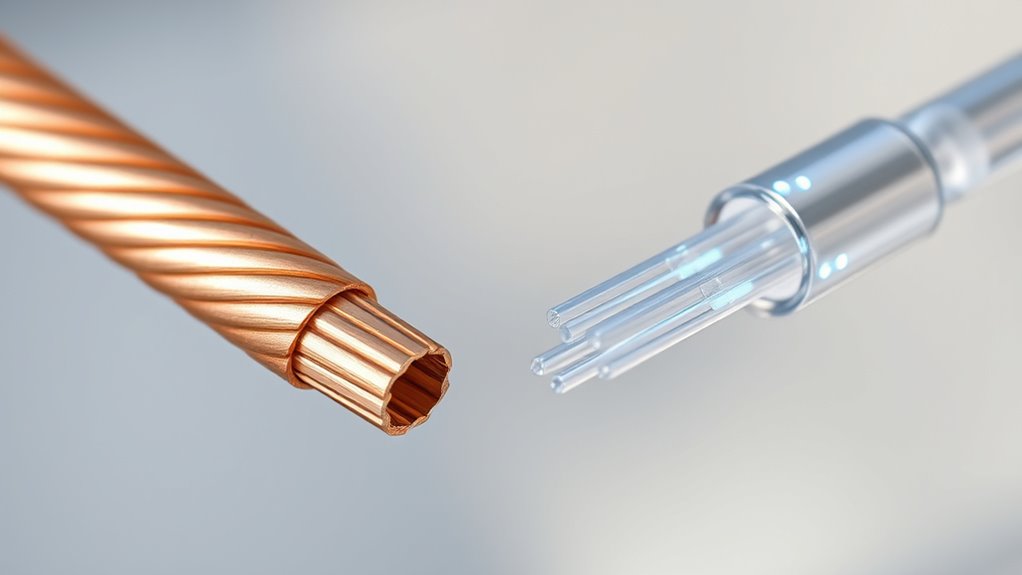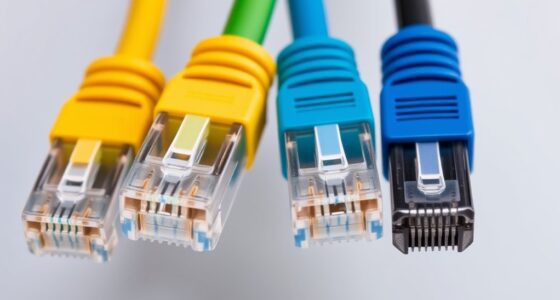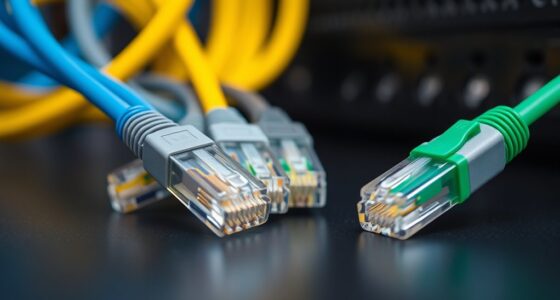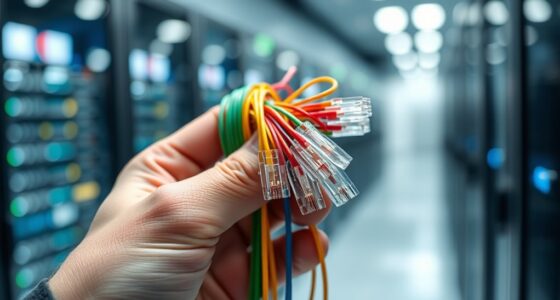When choosing between copper and fiber optic cables, understanding their differences can seem overwhelming. Copper offers affordability and simplicity, making it a common choice for small setups. Fiber, on the other hand, provides faster speeds and longer distances but comes with higher costs and complexity. Which option suits your needs best depends on your specific requirements, yet the decision isn’t always straightforward. Exploring the key aspects of each can help you make an informed choice.
Key Takeaways
- Copper cables are cheaper and easier to install, suitable for small networks; fiber offers higher capacity but requires specialized setup.
- Fiber transmits data via light over longer distances with less signal degradation, unlike copper which is limited in range.
- Fiber supports much higher speeds and bandwidth, ideal for demanding applications and future network growth.
- Copper is easier to tap physically, making it slightly more vulnerable to interception; fiber offers enhanced security due to difficulty in tapping.
- Fiber is more resistant to electromagnetic interference, providing more reliable performance in noisy environments, though with higher initial costs.

When choosing between copper and fiber optic cables, understanding their differences is crucial for ensuring your network meets your needs. Copper cables have been the standard for decades, mainly because they’re affordable and easy to install. They work well for short distances and are compatible with many existing systems. However, as technology advances, wireless alternatives have become more popular, reducing the reliance on physical cables. Still, if you’re considering wired options, copper remains a common choice for small offices or home networks. Copper cables are more susceptible to electromagnetic interference, which can cause signal degradation, especially over longer distances. This means you might experience slower speeds or dropped connections if your environment is noisy with electrical devices. Additionally, copper’s physical properties make it less ideal for high-bandwidth applications, such as streaming 4K videos or supporting large data transfers. But when it comes to network security, copper offers some advantages. Physical access to copper cables makes it harder for outsiders to intercept data without direct connection, adding a layer of security. On the other hand, fiber optic cables use light signals to transmit data, enabling much higher speeds over longer distances. This makes them ideal for large-scale networks, data centers, or environments where speed and capacity are critical. Although fiber cables are more expensive upfront, their resistance to electromagnetic interference ensures more reliable performance, especially in electrically noisy environments. Plus, fiber offers enhanced security because tapping into a fiber line is technically more challenging, reducing the risk of data breaches. As wireless alternatives continue to evolve, fiber optics provide a future-proof solution for high-demand networks. They can handle massive amounts of data, making them suitable for growing businesses or institutions that require fast, consistent connectivity. However, installing fiber can be more complex and costly, requiring specialized equipment and skills. Copper cables, on the other hand, are easier to install and repair, which can save time and money in the short run. When it comes to network security, fiber is generally considered more secure because intercepting data requires physically tapping the line, which is more detectable and difficult than wiretapping copper cables. Understanding the physical properties of copper, which make it less suitable for high-bandwidth applications, helps you make an informed decision. Overall, your choice depends on your specific needs—whether you prioritize cost, ease of installation, speed, or security. In environments where wireless alternatives are viable and security concerns are manageable, copper might suffice. But if you need high bandwidth, long-distance reliability, and robust security, fiber optics are the smarter choice. Understanding these differences helps you make a well-informed decision tailored to your network’s future growth and security requirements.
Frequently Asked Questions
How Does Installation Complexity Differ Between Copper and Fiber?
You’ll find that fiber optic installation has more challenges due to its delicate cables and precise handling requirements, making connection setup less straightforward. Copper wiring, on the other hand, offers easier installation with simpler connection processes, often requiring less specialized equipment. While fiber demands careful planning and skilled labor, copper’s installation challenges are generally lower, allowing for quicker setup and more straightforward connection, especially in existing infrastructure.
What Maintenance Is Required for Copper Versus Fiber Cables?
Think of maintenance like tending a garden—you need to care for your cables regularly. Copper cables require checking cable insulation for wear and tear, and connectors need to stay durable against corrosion. Fiber cables, on the other hand, demand less upkeep; they’re more resistant to environmental damage. Just make certain fiber connectors are clean, and avoid bending fibers too sharply. With proper care, your cables stay resilient and perform well over time.
Are There Environmental Considerations for Each Cable Type?
You should consider environmental factors like material toxicity and recycling options for each cable type. Copper cables contain toxic materials and are recyclable, but they need proper disposal to prevent environmental harm. Fiber optic cables are less toxic, more durable, and easier to recycle, making them a more eco-friendly choice overall. Proper disposal and recycling guarantee you minimize environmental impact, regardless of which cable type you select.
How Do Copper and Fiber Cables Impact Network Security?
Think of network security as a fortress; copper cables pose risks with physical tampering, making it easier for intruders to breach. Fiber cables, on the other hand, offer enhanced security because they’re harder to tap into. However, both are susceptible to encryption vulnerabilities. You’ll want to implement strong encryption and physical safeguards to protect your data, regardless of the cable type, ensuring your network remains a well-guarded castle.
What Are the Future Scalability Prospects for Copper and Fiber?
You’ll find that fiber optics offer better scalability prospects for future network expansion, as they support higher bandwidths and longer distances without significant upgrades. Copper cables face scalability challenges, limiting their ability to handle increasing data demands efficiently. As your needs grow, fiber becomes more cost-effective and adaptable, making it the ideal choice for expanding networks, while copper may struggle to keep pace with the evolving technology landscape.
Conclusion
Choosing between copper and fiber is like picking the right tool for a job—you’ll want copper for short, simple setups where cost matters, and fiber for long-term, high-speed needs. Copper is like a trusty bicycle—affordable and easy to handle, but limited in distance. Fiber is more like a sleek sports car—faster, more powerful, and built for the future. Decide what fits your needs, and you’ll keep your network running smoothly.









